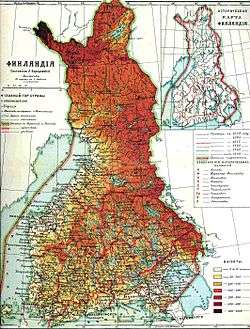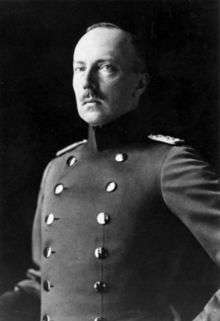Kingdom of Finland (1918)
| Kingdom of Finland | ||||||||||
| Suomen kuningaskunta (Finnish) Kungadömet Finland (Swedish) | ||||||||||
| ||||||||||
| ||||||||||
| Anthem Maamme / Vårt land "Our Land" | ||||||||||
 Map of the Grand Duchy of Finland, which had the same borders as independent Finland from 1917 until 1920. | ||||||||||
| Capital | Helsinki | |||||||||
| Languages | Finnish · Swedish | |||||||||
| Religion | Evangelical Lutheranism Finnish Orthodoxy | |||||||||
| Government | Regency | |||||||||
| Monarch | ||||||||||
| • | 1918–1919 | Vacant a | ||||||||
| Regent | ||||||||||
| • | 1918 | Pehr Evind Svinhufvud | ||||||||
| • | 1918–1919 | Carl Gustaf Mannerheim | ||||||||
| Prime Minister | ||||||||||
| • | 1918 | Juho Kusti Paasikivi | ||||||||
| • | 1918–1919 | Lauri Ingman | ||||||||
| • | 1919 | Kaarlo Castrén | ||||||||
| Legislature | Parliament | |||||||||
| Historical era | World War I / Interwar period | |||||||||
| • | Independence declared (as a republic) | 6 December 1917 | ||||||||
| • | Supreme authority given to regent | 18 May 1918 | ||||||||
| • | King elected | 9 October 1918 | ||||||||
| • | Parliamentary election | 3 March 1919 | ||||||||
| • | Republican constitution adopted | 17 July 1919 | ||||||||
| Currency | Finnish markka | |||||||||
| ||||||||||
| Today part of | | |||||||||
| a. Frederick Charles was elected King of Finland on 9 October 1918 and renounced the throne on 14 December 1918. | ||||||||||
The Kingdom of Finland (Finnish: Suomen kuningaskunta; Swedish: Kungadömet Finland) was an abortive attempt to establish a monarchy in Finland following Finland's independence from Russia. Had the German Empire endured, Prince Frederick Charles of Hesse could have been installed as the King of Finland.
History
Finland had declared independence from what was the Russian Empire, at that time embroiled in the Russian Civil War, on 6 December 1917. At the time of the declaration of independence, monarchists were a minority in the Finnish Parliament, and Finland was declared a republic. A civil war followed, and afterwards, while the pro-republic Social Democratic Party was excluded from the Parliament and before a new constitution was adopted, Frederick was elected to the throne of Finland on 9 October 1918.


Lithuania had already taken a similar step in July 1918, electing Wilhelm Karl, Duke of Urach, Count of Württemberg as King Mindaugas II of Lithuania. In Latvia and Estonia, a "General Provincial Assembly" consisting of Baltic-German aristocrats had called upon the German Emperor, Wilhelm II, to recognize the Baltic provinces as a joint monarchy and a German protectorate. Adolf Friedrich, Duke of Mecklenburg-Schwerin was nominated Duke of "the United Baltic Duchy" by the Germans.
At independence, Finland had, like the Baltic provinces, close ties with the German Empire. Germany was the only international power that had supported the preparations for independence, not the least by training volunteers as Finnish Jäger troops. Germany had also intervened in the Finnish Civil War, despite her own precarious situation. Finland's position vis-à-vis Germany was already evolving towards that of a protectorate by Spring 1918, and the election of Prince Frederick, brother-in-law of Wilhelm II, was viewed as a confirmation of the close relations between the two nations.
The adoption of a new monarchist constitution had been delayed because it did not get the required qualified majority (the legitimacy of the royal election was based upon the Instrument of Government of 1772, adopted under King Gustav III of Sweden, when Finland had been a part of Sweden. The same constitutional document had also served as the basis for the rule of the Russian Emperors, as Grand Dukes of Finland, during the 19th century.
Member of the Finnish Parliament Gustaf Arokallio suggested the monarchical designation "Charles I, King of Finland and Karelia, Duke of Åland, Grand Duke of Lapland, Lord of Kaleva and the North" (Finnish: Kaarle I, Suomen ja Karjalan kuningas, Ahvenanmaan herttua, Lapinmaan suuriruhtinas, Kalevan ja Pohjolan isäntä; Swedish: Karl I, Kung av Finland och Karelen, hertig av Åland, storhertig av Lappland, herre över Kaleva och Pohjola).[2]
By 9 November 1918, Wilhelm II had abdicated and Germany was declared a republic. Two days later, on 11 November 1918, the armistice between the belligerents of World War I was signed. Little is known of the Allied powers' view regarding the possibility of a German-born prince as the King of Finland. However, warnings received from the West convinced the Finnish government of Prime Minister Lauri Ingman – a monarchist himself – to ask Prince Frederick to give up the crown, which he had not yet come to wear in Finland.
The king-elect Frederick renounced the throne on 14 December 1918. Republican parties won three quarters of the parliament's seats in the election of 1919 and Finland adopted a republican constitution.
Other similar states
During World War I, the German Empire participated in the creation of various client states in territories that had belonged to Russia. These states were nevertheless nominally fully independent and sovereign:
- Duchy of Courland and Semigallia (1918)
- Kingdom of Lithuania (1918)
- Kingdom of Poland (1916–1918)
- United Baltic Duchy
See also
- Ancient kings of Finland
- Finnish Civil War
- Finnish crown jewels
- Grand Duchy of Finland
- Kingdom of Finland (1742)
- Monarchy of Finland
- Prince Wolfgang of Hesse
- United Baltic Duchy
References
| Wikimedia Commons has media related to 1918 in Finland. |
- ↑ "Jalokivigalleriaa". kemi.fi.
- ↑ Ohto Manninen (päätoim.), Pertti Haapala, Juhani Piilonen, Jukka-Pekka Pietiäinen: Itsenäistymisen vuodet 1917–1920: 3. Katse tulevaisuuteen. Helsinki: Valtionarkisto, 1992. ISBN 951-37-0729-6. pp. 188–189
- Nash, Michael L (2012) The last King of Finland. Royalty Digest Quarterly, 2012 : 1
Coordinates: 60°10′N 024°56′E / 60.167°N 24.933°E
.svg.png)
.svg.png)